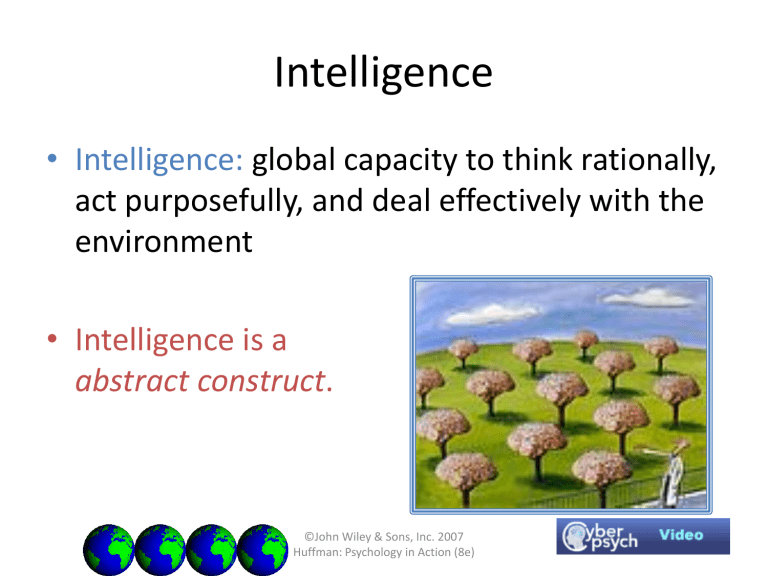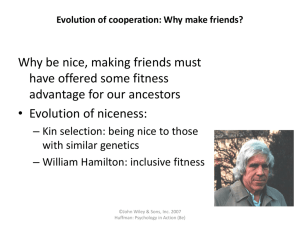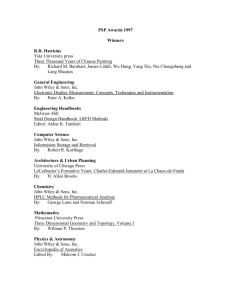Intelligence and Emotion - Southeastern Louisiana University

Intelligence
• Intelligence: global capacity to think rationally, act purposefully, and deal effectively with the environment
• Intelligence is a hypothetical,
abstract construct.
©John Wiley & Sons, Inc. 2007
Huffman: Psychology in Action (8e)
History of Intelligence Testing
• 1905: Alfred Binet creates test measure intellectual skills of children entering French public school system.
• Lewis Terman translates test and brings to Stanford
University in CA (Stanford-
Binet Test of Intelligence)
©John Wiley & Sons, Inc. 2007
Huffman: Psychology in Action (8e)
History of Intelligence Testing
• David Wechsler (1939) creates intelligence test for adults composed of 11 subscales measuring both verbal and nonverbal (or performance) IQ.
• Most popular IQ tests today
• WAIS – adults; WISC – children;
WPPSI – preschool children
©John Wiley & Sons, Inc. 2007
Huffman: Psychology in Action (8e)
WWII: First Group Aptitude Measures
• Army Alpha and Beta
©John Wiley & Sons, Inc. 2007
Huffman: Psychology in Action (8e)
What Is Intelligence?
Historical views of intelligence:
1. S ingle ability or general factor called “g”
(Spearman)
2. Multiple abilities (Thurstone and Guilford)
3. Single ability with two types of g, fluid and crystallized intelligence (Cattell)
4. Multiple abilities (Gardner and Sternberg)
©John Wiley & Sons, Inc. 2007
Huffman: Psychology in Action (8e)
• Gardner
Intelligence Models
• Sternberg
©John Wiley & Sons, Inc. 2007
Huffman: Psychology in Action (8e)
©John Wiley & Sons, Inc. 2007
Huffman: Psychology in Action (8e)
©John Wiley & Sons, Inc. 2007
Huffman: Psychology in Action (8e)
Measuring Intelligence
• Stanford-Binet and Wechsler most widely used individual intelligence tests. Both tests compute an intelligence quotient (IQ) , which compares the deviation of a person’s test score to norms for that person’s age group.
– Original version of Stanford-Binet
(IQ = MA/CA x 100)
©John Wiley & Sons, Inc. 2007
Huffman: Psychology in Action (8e)
Measuring Intelligence—The Normal
Distribution of IQ Scores
©John Wiley & Sons, Inc. 2007
Huffman: Psychology in Action (8e)
Intelligence:
Normal Distribution
Measuring Intelligence—
Sample Wechsler Tests
©John Wiley & Sons, Inc. 2007
Huffman: Psychology in Action (8e)
Measuring Intelligence
• Three scientific standards for psychological tests:
1. Standardization-establishes norms and uniform procedures for giving and scoring tests
2. Reliability-measure of the consistency and stability of test scores over time
3. Validity-ability of a test to measure what it was designed to measure
©John Wiley & Sons, Inc. 2007
Huffman: Psychology in Action (8e)
The Intelligence Controversy—
Extremes in Intelligence
• Mental Retardation:
IQs of 70 and below
• Mental Giftedness:
IQs of 135 and above
©John Wiley & Sons, Inc. 2007
Huffman: Psychology in Action (8e)
©John Wiley & Sons, Inc. 2007
Huffman: Psychology in Action (8e)
Influences on Testing
Cultural Bias in Testing
– culture-fair tests (e.g., Raven Progressive Matrices)
Genetic Influences on Intelligence
– heritability
– increases with age
Environmental Influences on Intelligence
– Flynn effect
The Intelligence Controversy:
Explaining Differences
• Is it the brain? All mental activity
(including intelligence) results from neural activity in the brain.
• Is it genetic or environmental influences?
Heredity and environment are important, inseparable factors in intellectual development.
©John Wiley & Sons, Inc. 2007
Huffman: Psychology in Action (8e)
The Flynn Effect
An Example of a Brain Test for Intelligence
• Which “leg” of the drawing is longer (a) or
(b)?
The amount of time individuals require to make a correct choice between quickly flashed items like the ones on this screen may reveal something about their intelligence.
©John Wiley & Sons, Inc. 2007
Huffman: Psychology in Action (8e)
An Example of Genetic Vs. Environmental
Influences on Intelligence
©John Wiley & Sons, Inc. 2007
Huffman: Psychology in Action (8e)
Theories and Concepts of Emotion
• Three Components of Emotion
1.
Physiological-arousal comes from brain (particularly the limbic system) and autonomic nervous system
(ANS)
©John Wiley & Sons, Inc. 2007
Huffman: Psychology in Action (8e)
Physiological Component and the
Autonomic Nervous System (ANS)
©John Wiley & Sons, Inc. 2007
Huffman: Psychology in Action (8e)
Emotion and the Brain
Limbic System: Amygdala
• fear system: two pathways thalamus ↔ amygdala sensory cortex
• persistence of emotional memories
Cerebral Hemispheres
– left hemisphere: approach-related emotions
– right hemisphere: withdrawal-related emotions
Theories and Concepts of Emotion
• Three Components of Emotion (Continued)
2. Cognitive --thoughts, values and expectations
3. Behavioral --expressions, gestures, and body positions
©John Wiley & Sons, Inc. 2007
Huffman: Psychology in Action (8e)
Theories and Concepts of Emotion--
Four Theories of Emotion
• James-Lange: emotions occur after arousal
• Cannon-Bard: arousal and emotion occur simultaneously
• Facial-Feedback: facial movements elicit arousal and specific emotions
• Schachter’s Two-Factor: arousal leads to search for label and then emotion occurs
©John Wiley & Sons, Inc. 2007
Huffman: Psychology in Action (8e)
Theories and Concepts of Emotion:
•
Overview of
Four Theories of Emotion
©John Wiley & Sons, Inc. 2007
Huffman: Psychology in Action (8e)
Can You Explain Why Pleasant Feelings
Increase When Teeth Show?
©John Wiley & Sons, Inc. 2007
Huffman: Psychology in Action (8e)
Facial Feedback Hypothesis: changes in facial expression produce corresponding changes in emotion
• Laird (1974): attached electrodes to students faces to study facial muscles. Showed them cartoons. Ask subs to contract muscles to form either smile or frown. Those who smiled while seeing cartoons rated them as funnier.
• Kleinke et al., (1998). Had subjects model either pictures, most either happy or sad.
Rated emotions. Happy faces happier.
• Zajonc (1993). Cool brain hypothesis
©John Wiley & Sons, Inc. 2007
Huffman: Psychology in Action (8e)
Facial expressions: Universal expressions of emotions
• Paul Ekman (1970’s) series of cross-cultural studies looking for universals in facial expressions of emotions
• Based on evolutionary principle that it would have been advantageous for a highly social species to be able to quickly read emotions from faces.
©John Wiley & Sons, Inc. 2007
Huffman: Psychology in Action (8e)
Universal Facial Expressions
• Ekman & Friesen (1978) identified six universal facial expressions: joy, fear, anger, sadness, surprise and disgust.
©John Wiley & Sons, Inc. 2007
Huffman: Psychology in Action (8e)
Lying faces: Can we identify when a face is lying?
• Ekaman Telling Lies (2001). microexpression: brief, fleeting facial expression of the opposite emotion to what the person is trying to convey
• 90% of deceivers produce reliable microexpression. 30% of truth-tellers also do.
• Other cues: depersonalization of speech, departure from typical communication style.
• Ekman’s advice: always play good cop
• Avner Less/Adolf Eichmann example.
©John Wiley & Sons, Inc. 2007
Huffman: Psychology in Action (8e)
• MicroExpression Training Tools (METT) and Subtle
Expression Training Tools (SETT) provide self instructional training to improve your ability to recognize facial expressions of emotion. In under an hour, METT will train you to see very brief (1/25th of a second) microexpressions of concealed emotion. SETT teaches you to recognize the subtlest signs of when an emotion is first beginning in another person.
*©Paul Ekman 2004
©John Wiley & Sons, Inc. 2007
Huffman: Psychology in Action (8e)
Schachter two factor theory of emotion
• Two factors: physiological arousal and cognitive evalution
• We take note of physio arousal and label arousal with emotional tag appropriate to situation.
• Is it love or is it gas?
©John Wiley & Sons, Inc. 2007
Huffman: Psychology in Action (8e)
What Theory of Emotion is
Portrayed in this Figure?
©John Wiley & Sons, Inc. 2007
Huffman: Psychology in Action (8e)
Happiness: An elusive emotion
• Why humans aren’t designed to be happy
• 1. Hedonic treadmill: we quickly adapt to new circumstances requiring ever greater “thrills” to achieve contentment (the more you have the more you want!)
• 2. Tendency to make upward rather than downward social comparisons
• 3. Asymmetry of affective experience effect: losing $50 dollars feels worse than finding $50 feels good.
©John Wiley & Sons, Inc. 2007
Huffman: Psychology in Action (8e)
Happiness: Does money buy happiness?
• Yes and no: Enough money to establish a health and security, but past that no effect
• Of greater importance: stability and depth of social relationships – marriage, family, community.
©John Wiley & Sons, Inc. 2007
Huffman: Psychology in Action (8e)
©John Wiley & Sons, Inc. 2007
Huffman: Psychology in Action (8e)
©John Wiley & Sons, Inc. 2007
Huffman: Psychology in Action (8e)
©John Wiley & Sons, Inc. 2007
Huffman: Psychology in Action (8e)
©John Wiley & Sons, Inc. 2007
Huffman: Psychology in Action (8e)
The secret to Happiness: Ancient wisdom
• Here again, I saw emptiness under the sun: a lonely man without a friend, without a son or brother, toiling endlessly yet never satisfied with his wealth. Two are better than one; they receive a good reward for their toil, because, if one falls, the other can help his companion up again; but alas for the man who falls with no partner to help him up. (Eccles. 4:7-10).
©John Wiley & Sons, Inc. 2007
Huffman: Psychology in Action (8e)







